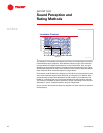
10 TRG-TRC007-EN
notes
period one
Fundamentals of Sound
The following comparison of sound and light may help illustrate the distinction
between these two properties. Think of sound power as the wattage rating of a
light bulb. Both measure a fixed amount of energy. Whether you put a 100-watt
light bulb outdoors or in a closet, it is always 100-watt light bulb and always
gives off the same amount of light.
Sound pressure corresponds to the brightness, from the light emitted by the
light bulb, in a particular location in the room. Both sound pressure and
brightness can be measured with a meter, and the immediate surroundings
influence the magnitude of each. In the case of light, brightness depends on
more than the wattage of the bulb. It also depends on how far the observer is
from the light bulb, the color of the room, how reflective the wall surfaces are,
and whether the light bulb is covered with a shade. These other factors affect
how much light reaches the receiver, but do not affect the wattage of the light
bulb.
Similarly, sound pressure depends not only on the sound power emitted by the
source, but also on the characteristics of the surrounding environment. These
might include the distance between the sound source and the listener, whether
the room is carpeted or tiled, and whether the room is furnished or bare. Just as
with light, environmental factors like these affect how much sound reaches the
listener.
An Analogy
I Sound power
K Correlates to bulb wattage
I Sound pressure
K Correlates to brightness
Figure 12


















